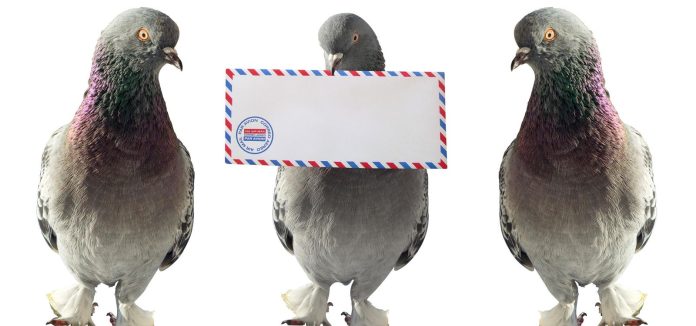Air mail delivery is an essential part of modern life. The history of this unique invention goes … [+]
Long before the invention of modern aviation technology, societies relied on homing pigeons to send messages across long distances. A trained homing pigeon, for instance, could deliver a message over a distance of 100 miles in about two hours.
A skilled horse rider might take a day or longer to cover the same distance—and that assumes there were no waterways or mountains to traverse.
Homing pigeons were primarily used to transmit handwritten messages, taped to their legs and inscribed on rice paper, parchment or vellum. The messages were typically sent in waterproof capsules to ensure they were delivered intact.
Tiny scrolls were carefully rolled, sealed in waterproof capsules, and strapped to a pigeon’s leg … [+]
However, in the 900s A.D., the Arab historian al-Maqrizi described a peculiar—and possibly groundbreaking—application of “pigeon post.” He wrote that a powerful caliph of the Fatimid dynasty in northern Africa requested that 600 Lebanese cherries be couriered to him via pigeon post.
Because pigeons are small animals, they can only carry up to a couple ounces of cargo taped to their legs. So, his officials coordinated the release of 600 pigeons from Baalbek, Lebanon, each carrying a small pouch containing a single cherry for the Caliph. The birds traveled over 400 miles to Cairo, making this possibly the earliest instance of airmail delivery.
Later societies took note of the delivery. For instance, in the early 1900s, right around the time the Wright brothers were developing the world’s first airplane, German pharmacies were using pigeon post to distribute essential medicines.
Here’s a bit more detail on the fascinating bird species that enabled these first-of-a-kind deliveries.
The Uncanny Genius Of The Homing Pigeon
Homing pigeons (Columba livia domestica) are a domesticated subspecies of rock pigeons known for their remarkable ability to navigate and return to a specific location over long distances. This skill has been invaluable to humans for thousands of years, particularly for delivering messages during times of war and in areas with limited communication technologies. Pigeons are equipped with an incredible sense of direction, allowing them to travel back home from unfamiliar locations.
These birds use several mechanisms to navigate.
They are believed to rely on the Earth’s magnetic field, utilizing specialized receptors in their beaks to detect magnetic cues. Additionally, pigeons use the sun’s position and visual landmarks like rivers or mountains to guide their journey. Their exceptional sense of smell is also thought to help them recognize specific locations, making them highly reliable navigators over vast areas.
Training homing pigeons for message delivery involves imprinting them to a particular loft or location. Once trained, pigeons can be taken to distant places and released, using their navigational abilities to return home. Messages, typically written on small pieces of paper, are attached to the pigeon’s leg in a small canister or capsule. Their impressive speed, reaching 50-65 miles per hour, allows them to cover long distances efficiently, sometimes up to 600 miles in a single day.
Historically, homing pigeons played a crucial role in wartime communication, particularly during World War I and World War II. Military forces relied on pigeons to carry critical messages when other communication lines were unavailable or unreliable. Some pigeons became famous for their bravery, even receiving medals for their service. Outside of wartime, pigeons were used in ancient civilizations like Egypt and India as a reliable method of communication.
The ability of homing pigeons to deliver messages is the result of natural instincts and selective breeding. While all pigeons have an innate drive to return home, homing pigeons have been specifically bred for their enhanced navigational skills, making them the ideal choice for message delivery. Their unique abilities have made them one of the oldest and most fascinating methods of long-distance communication.
Are you an animal lover who owns a pet, perhaps even a bird? Take the science-backed Pet Personality Test to know how well you know your little friend.




